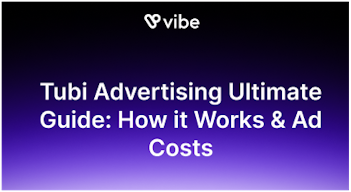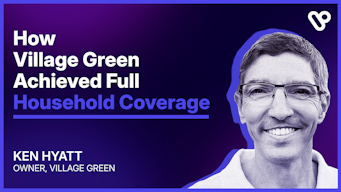How Much Does It Cost to Run a CTV Campaign?
How much do CTV ads cost?
Television has always been considered one of the most expensive advertising mediums, reserved solely for the ‘big boys’ with huge media budgets and eye-watering production costs. Think of the news generated by Super Bowl ads before they even run.
But with Connected TV, the rules have changed. How much does it cost to advertise on CTV? Keep reading our article to find out!
Paying for trackable performance
How much does it cost to advertise on CTV vs. on linear TV? On paper, the rates for CTV advertising are higher than the median CPM (Cost-Per-Thousand) for linear television, which hovers between $10 and $15. The average CPM for YouTube videos, on the other hand, runs at $20 to $25, and that of CTV can range from $35 to $65.
But CPMs aren’t the way to measure ROI. CTV advertising offers a level of targeting that is simply inconceivable from linear TV ads. This gives CTV the edge in terms of cost performance. In fact, consumers typically view up to 95% of the CTV ads they are exposed to, bringing down the CPCV (Cost-Per-Completed-View) significantly.
In addition, linear TV advertising requires advertisers to pay whether the viewers are interested in the ad or not. With CPCV programmatic campaigns, on the other hand, audiences must watch at least 30 seconds worth of the video ad – and sometimes even the full ad – to be counted as a ‘view’. This means that viewers who only watch part of an ad or skip it altogether do not affect the cost of the campaign, and advertisers are charged only when the ad performs.
What is included in the cost of an OTT commercial?
If you’re wondering, ‘How much does it cost to advertise on CTV?’, you’ll probably want to know about OTT as well. CTV advertising allows you to run your ads on multiple connected devices, including smart TVs with a built-in Internet connection and TVs that get their connection through an external device or a connected gaming console.
OTT refers to programming that is watched through a connected device such as a smartphone, a tablet, or a computer. It doesn’t include television sets, unless they are equipped with a CTV dongle (Roku or Amazon Fire Stick, for example) to stream video content from a connected device or a computer. OTT commercials can be shown on multiple streaming platforms, including Hulu, ESPN, HBO Now, and more.
How to measure CTV Ads cost?
How much does it cost to advertise on CTV and run your ads on Hulu, Roku, or on YouTube?
Many factors go into running a CTV ad, so costs tend to vary considerably. One of the main elements to consider is your audience, based on your specific niche as well as where you wish to run your ad. The larger the relevant audience, the higher the cost, which is also why a CTV ad will have a greater CPM than a local TV spot.
Demand can also make CTV advertising rates fluctuate. Using the Vibe platform will help you set a daily budget for your campaign. You can also determine a fixed amount to be spent over the duration of the entire campaign. Instead of having to measure how much it costs to advertise on CTV and to keep an eye on CPM fluctuations, you have full control over your spend.
More budget flexibility with connected TV Ads
Connected TV offers a number of benefits for advertisers, including more budget flexibility; and with the rise of programmatic buying, connected TV ads are easier to buy and place than ever before.
How much does it cost to advertise on CTV successfully? Well, it all depends on what your expectations are; but what makes connected TV ads so unique is that you can get a significant return on your investment regardless of how much (or how little) you spent in the first place. By setting your own rules, you can allocate your budget as you see fit, giving you the flexibility to refine your strategy as you go, without any constraints.
Flexible budgeting and the ability to tailor your advertising strategy to your own needs makes CTV a particularly attractive option for those looking to get the most out of their advertising dollars.
Low minimum budget
While ‘traditional’ linear TV requires huge budgets up front, often ranging in the several hundreds of thousands of dollars, Connected TV delivers brands and marketers flexibility, accessibility and simplicity.
Technically, you could spend only $100 on CTV advertising, but that wouldn’t be the smartest or most effective business decision. The minimum budget really depends on the target population you’re trying to reach. You can reach a narrow target within a well-defined, specialized niche for just a few thousand dollars, whereas a national ad campaign on premium broadcast networks in prime time will cost millions of dollars.
Conversely, Vibe affords you the freedom to run ads on premium TV content from CNN, National Geographic or the NFL without blowing your budget as opposed to enormous budgets and huge guaranteed buys on traditional TV.
YOU CONTROL THE PRICE
With connected TV, you have the power to control the budget of your ad campaigns. You can set a limit on how much you’re willing to spend on each ad, choose to target specific viewers to ensure that your message is seen by the right people, and therefore control your budget more effectively.
Once you’ve decided your budget, you’ll need to determine the CPM (Cost per thousand) you’re willing to pay. CPM is another term from the ad world, where the M is actually mille (thousand) just like in Roman numerals. When buying digital advertising on the open web, marketers set the price they’re willing to pay per thousand impressions. Vibe’s powerful bidding algorithm gets you the best price per mille every time. You can also do this via search engine ads and other PPC (pay-per-click) platforms.
With Connected TV, we see the CPM vary anywhere from $10 all the way up to $70, and the average is usually around $30. The CPM you’ll need to pay greatly depends on the content – and therefore the viewers – you’re targeting. Some channel providers demand a high CPM, while others are less restrictive.
As this article has hopefully demonstrated, CTV is for just about every brand and every marketer. You needn’t worry about your budget, just get started and see how easy it is!


